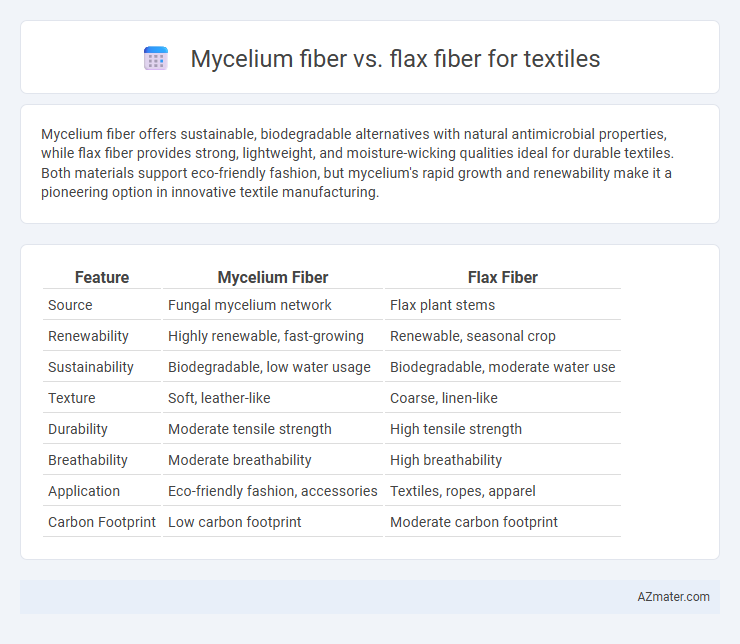Mycelium fiber offers sustainable, biodegradable alternatives with natural antimicrobial properties, while flax fiber provides strong, lightweight, and moisture-wicking qualities ideal for durable textiles. Both materials support eco-friendly fashion, but mycelium's rapid growth and renewability make it a pioneering option in innovative textile manufacturing.
Table of Comparison
| Feature | Mycelium Fiber | Flax Fiber |
|---|---|---|
| Source | Fungal mycelium network | Flax plant stems |
| Renewability | Highly renewable, fast-growing | Renewable, seasonal crop |
| Sustainability | Biodegradable, low water usage | Biodegradable, moderate water use |
| Texture | Soft, leather-like | Coarse, linen-like |
| Durability | Moderate tensile strength | High tensile strength |
| Breathability | Moderate breathability | High breathability |
| Application | Eco-friendly fashion, accessories | Textiles, ropes, apparel |
| Carbon Footprint | Low carbon footprint | Moderate carbon footprint |
Introduction to Mycelium Fiber and Flax Fiber
Mycelium fiber, derived from the root structure of fungi, offers a sustainable and biodegradable alternative to traditional textiles, exhibiting natural antibacterial properties and durability. Flax fiber, harvested from the flax plant, is renowned for its strength, breathability, and moisture-wicking capabilities, making it a staple in linen fabric production. Both fibers contribute to eco-friendly textile innovations, with mycelium highlighting fungal biomass potential and flax emphasizing plant-based cellulose excellence.
Origins and Production Processes
Mycelium fiber is derived from the root-like structures of fungi, cultivated through controlled growth on organic substrates, resulting in a sustainable, biodegradable textile material with rapid production cycles. Flax fiber originates from the flax plant's stalks, requiring harvesting, retting to separate fibers, and mechanical extraction, a process deeply rooted in traditional agriculture with a longer production timeline. Both fibers emphasize eco-friendly attributes, but mycelium's fungal cultivation contrasts with flax's plant-based agricultural methods, influencing texture, scalability, and environmental impact in textile manufacturing.
Material Properties and Structure
Mycelium fiber exhibits a unique hierarchical structure characterized by interwoven hyphal networks, providing exceptional tensile strength and natural antimicrobial properties. Flax fiber consists of long, cellulose-rich bast fibers with high crystallinity, offering excellent durability, moisture absorption, and breathability ideal for textile applications. The biodegradability and lightweight nature of mycelium fibers contrast with flax's rigidity and traditional use in linen production, making each fiber suitable for different textile innovations.
Sustainability and Environmental Impact
Mycelium fiber and flax fiber both offer sustainable alternatives to conventional textiles, with mycelium fiber derived from fungal roots produced via low-energy processes and renewable substrates, minimizing carbon emissions and waste. Flax fiber, sourced from the flax plant, is highly biodegradable, requires less water and pesticides compared to cotton, and promotes soil health through crop rotation. Both fibers reduce reliance on synthetic materials but mycelium fiber's rapid growth cycle and potential to utilize agricultural waste give it a distinct advantage in reducing environmental impact.
Mechanical Strength and Durability
Mycelium fiber exhibits exceptional mechanical strength due to its dense network of chitin and glucans, providing high tensile strength and resilience under stress, making it a viable alternative to conventional fibers. Flax fiber, renowned for its superior tensile strength and stiffness, demonstrates excellent durability in textile applications, being resistant to wear and environmental factors such as moisture and UV exposure. Comparative studies indicate flax fibers generally outperform mycelium in long-term durability, while mycelium offers innovative sustainability benefits without compromising essential mechanical properties.
Textile Applications and Versatility
Mycelium fiber offers unique sustainability advantages and biodegradability, making it an emerging material in eco-friendly textile applications such as fashion, upholstery, and accessories. Flax fiber, known for its strength, breathability, and moisture-wicking properties, is widely used in linen production, home textiles, and apparel, demonstrating proven versatility across various textile markets. Both fibers serve different purposes; mycelium fiber excels in innovative, sustainable designs, while flax maintains reliability and durability in traditional and commercial textile goods.
Biodegradability and End-of-Life Options
Mycelium fiber and flax fiber both offer excellent biodegradability, with mycelium decomposing rapidly due to its fungal origin, and flax breaking down naturally as a plant-based textile. In terms of end-of-life options, mycelium fiber can be composted or biodegraded in industrial and home settings, while flax fiber also supports composting but is widely accepted in conventional recycling streams. Both fibers provide sustainable alternatives to synthetic textiles, minimizing environmental impact through efficient decomposition and renewable sourcing.
Cost and Scalability in the Textile Industry
Mycelium fiber offers innovative sustainability benefits but remains costlier than flax fiber due to limited production scale and nascent extraction technologies. Flax fiber benefits from an established global supply chain with mature agricultural practices, resulting in lower costs and high scalability for mass textile manufacturing. Textile industries seeking cost-effective large-volume supply typically favor flax, while mycelium fiber targets niche markets emphasizing eco-friendly materials.
Consumer Perception and Acceptance
Mycelium fiber offers a novel, sustainable alternative in textiles, attracting eco-conscious consumers seeking innovative materials with lower environmental impact compared to traditional fibers like flax. Flax fiber benefits from established recognition due to its natural origin, durability, and breathability, leading to high consumer acceptance in eco-friendly and premium textile markets. Consumer perception of mycelium fiber is evolving positively as awareness of its biodegradability and unique texture grows, yet widespread acceptance depends on overcoming unfamiliarity and price competitiveness relative to flax.
Future Prospects and Innovations
Mycelium fiber offers significant future prospects in textile manufacturing due to its biodegradability, sustainability, and ability to be engineered for specific textures and strengths, presenting a revolutionary alternative to traditional fibers. Innovations in mycelium processing technology are enabling scalable production and enhanced durability, making it a promising eco-friendly substitute to flax fiber, which has long been valued for its natural strength and breathability but faces limitations in water usage and processing complexity. Emerging research focuses on hybrid materials combining mycelium and flax fibers to optimize performance, reduce environmental impact, and meet growing consumer demand for sustainable textiles.

Infographic: Mycelium fiber vs Flax fiber for Textile
 azmater.com
azmater.com